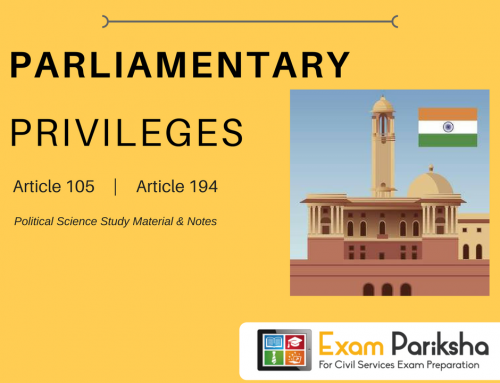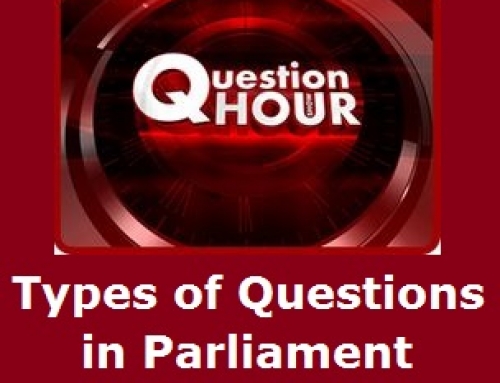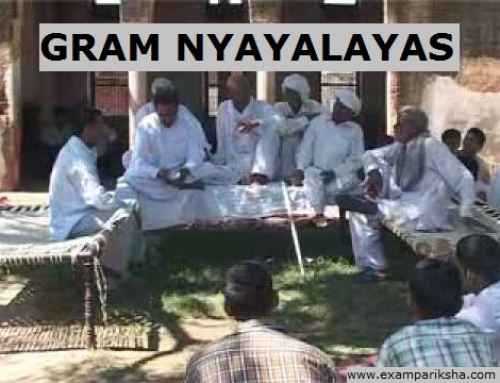India has a parliamentary democracy. There is a Council of Ministers headed by the Prime Minister who enjoys the real powers and is responsible to the Parliament,which is elected by the people by universal adult franchise. The Indian Constitution provides for Fundamental Rights which are justiciable. There is a mention of the Fundamental Duties which have been added to the Constitution later. India just has single citizenship. The Directive Principles of State Policy give a concrete shape to the welfare state.

- A Written Constitution: A written constitution is framed at a given time and comes into force on a fixed date as a document. Our constitution was framed in 2 years, 11 months and 18 days, it was adopted on 26th November, 1949 and enforced on January 26, 1950.
- Rigid and Flexibile: The Indian Constitution is a unique example of combination of rigidity and flexibility.A constitution is called rigid or flexible on the basis of its amending procedure. In a rigid constitution, amendment of the constitution is not easy like the constitutions of USA, Switzerland and Australia are rigid constitutions. Whereas, the British Constitution is considered flexible because its amendment procedure is easy and simple. The Constitution of India has three categories of amendments ranging from simple to most difficult procedure depending on the nature of the amendment.
- Federal Polity: India has a federal structure. In a federation there are two distinct levels of governments. There is one government for the whole country which is called the Union or Central Government and there is a government for each Unit or State.The USA is a federation whereas the UK(Britain) has a unitary form of government where there is only one government for the whole country and the power is centralised.The Constitution of India does not use the term ‘federal state’ but calls India a ‘Union of States’. There is a proper distribution of powers between the Union/Central Government and the State Governments in form of Union List, State List and the Concurrent List.
- Quasi Federal: It means a federal set up where despite having two clear sets of government – central and the states, more powers are given to the Central Government, supremacy of the judiciary is an essential feature of a federation so that the constitution could be interpreted impartially.
- Parliamentary Democracy: India has a parliamentary form of democracy.This has been adopted from the British system. In a parliamentary democracy there is a close relationship between the legislature and the executive. The Cabinet is selected from among the members of legislature. The cabinet is responsible to the latter. In this form of democracy, the Head of the State is nominal so in India, the President is the Head of the State. Constitutionally the President has numerous powers but in practice the Council of Ministers headed by the PM, exercises these powers. The President has to act on the advice of the Prime Minister and the Council of Ministers.
- Fundamental Rights and Fundamental Duties: The Constitution of India guarantees Fundamental rights. The Constitution provides for six Fundamental Rights which are justiciable and hence are protected by the judiciary. Fundamental Duties were added to our Constitution by the 42nd Amendment. It lays down a list of ten Fundamental Duties for all citizens of India. While the rights are given as guarantees to the people, the duties are obligations which every citizen is expected to perform.
- Directive Principles of State Policy: These have been adopted from the Irish Constitution, included in our Constitution to ensure social and economic justice to our people. Directive Principles aim at establishing a welfare state in India where there will be no concentration of wealth in the hands of a few.
- Single Integrated Judicial System: India has a single integrated judicial system. The Supreme Court is the apex court of the judicial system. Below it are the High Courts which control and supervise the lower courts. The Indian judiciary is like a pyramid with the lower courts as the base, High Courts in the middle and the Supreme Court at the top.
- Independence of Judiciary: Indian judiciary is independent and impartial. It is free from the influence of the executive as well as the legislature. Its judges are appointed on the basis of their qualifications and cannot be removed easily neither can their terms of office be altered to their disadvantage.
- Single Citizenship: Usually in a federal state the citizens enjoys double citizenship like in the USA. But in India there is only single citizenship which means that every Indian is a citizen of India, irrespective of the place of his/her residence or place of birth. He/she is not a citizen of the Constituent State like Rajasthan, Uttaranchal or Chattisgarh to which he/she may belong to. All the citizens of India can secure employment anywhere in the country and enjoy all the rights equally in all the parts of the nation.
- Universal Adult Franchise: Indian democracy functions on the basis of ‘one person one vote’. The Indian Constitution establishes political equality in India through the method of universal adult franchise. Every citizen of India who is 18 years of age or above is entitled to vote in the elections irrespective of caste, sex, race, religion or status.
- Emergency Provisions: The Constitution makers expected that there could be situations when the government could not be run in usual manner due to difficult circumstances. To cope with such situations, the Constitution elaborated on emergency provisions. There are three types of emergency; A) emergency caused by war, external aggression or armed rebellion; B) emergency arising out of the failure of constitutional machinery in states; and C) financial emergency.





